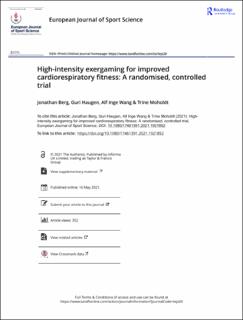| dc.contributor.author | Berg, Jonathan | |
| dc.contributor.author | Haugen, Guri | |
| dc.contributor.author | Wang, Alf Inge | |
| dc.contributor.author | Moholdt, Trine | |
| dc.date.accessioned | 2021-10-28T08:59:15Z | |
| dc.date.available | 2021-10-28T08:59:15Z | |
| dc.date.created | 2021-08-10T16:29:59Z | |
| dc.date.issued | 2021 | |
| dc.identifier.citation | European Journal of Sport Science. 2021, 1-11. | en_US |
| dc.identifier.issn | 1746-1391 | |
| dc.identifier.uri | https://hdl.handle.net/11250/2826210 | |
| dc.description.abstract | Exergaming has been proposed as a promising alternative to traditional endurance training since many experience exergaming as more enjoyable. Therefore, the aim of this trial was to determine the exergaming-induced effect on cardiorespiratory fitness. This parallel-group randomised controlled trial, investigated the effects of regular exergaming among healthy adults (aged ≥ 18 years) who were not endurance-trained. Participants allocated to the exergaming group (n = 13) used the Playpulse exergaming platform for a minimum of 45 min twice weekly for eight weeks, whereas the control group (n = 17) received no intervention. The primary outcome measure was the between-group difference in peak oxygen uptake (V̇O2peak) after the intervention. V̇O2peak increased significantly from baseline (43.9 [SD 7.0]) to after the intervention (45.3 [SD 8.2] mL kg−1 min−1) in the exergaming group, compared to the control group (42.4 [SD 7.0] to 42.0 [SD 5.7] L·kg−1·min−1) with a between-group difference of 2.1 mL kg−1 min−1 (95% CI: 0.2–4.1; p = 0.04). The average score on the Feeling Scale reported during exergaming was 3.4 (95% CI 3.2–3.6), with 3 being “good” and 5 “very good” and was not related to the participants’ exergaming skills. There were no adverse events during this trial. Two weekly sessions using the Playpulse exergaming platform can improve V̇O2peak. This finding suggests that exergaming can be an efficient form of endurance training. Furthermore, our findings indicate that participants’ enjoyed exergaming irrespective of exergaming skills. Trial registration: ClinicalTrials.gov identifier: NCT04112329 | en_US |
| dc.language.iso | eng | en_US |
| dc.publisher | Taylor & Francis | en_US |
| dc.rights | Attribution-NonCommercial-NoDerivatives 4.0 Internasjonal | * |
| dc.rights.uri | http://creativecommons.org/licenses/by-nc-nd/4.0/deed.no | * |
| dc.title | High-intensity exergaming for improved cardiorespiratory fitness: A randomised, controlled trial | en_US |
| dc.type | Peer reviewed | en_US |
| dc.type | Journal article | en_US |
| dc.description.version | publishedVersion | en_US |
| dc.source.pagenumber | 1-11 | en_US |
| dc.source.journal | European Journal of Sport Science | en_US |
| dc.identifier.doi | 10.1080/17461391.2021.1921852 | |
| dc.identifier.cristin | 1925178 | |
| dc.relation.project | Samarbeidsorganet mellom Helse Midt-Norge og NTNU: 17/38297 | en_US |
| dc.relation.project | Norsk fysioterapeutforbund: 97832 | en_US |
| cristin.ispublished | true | |
| cristin.fulltext | original | |
| cristin.qualitycode | 1 | |

